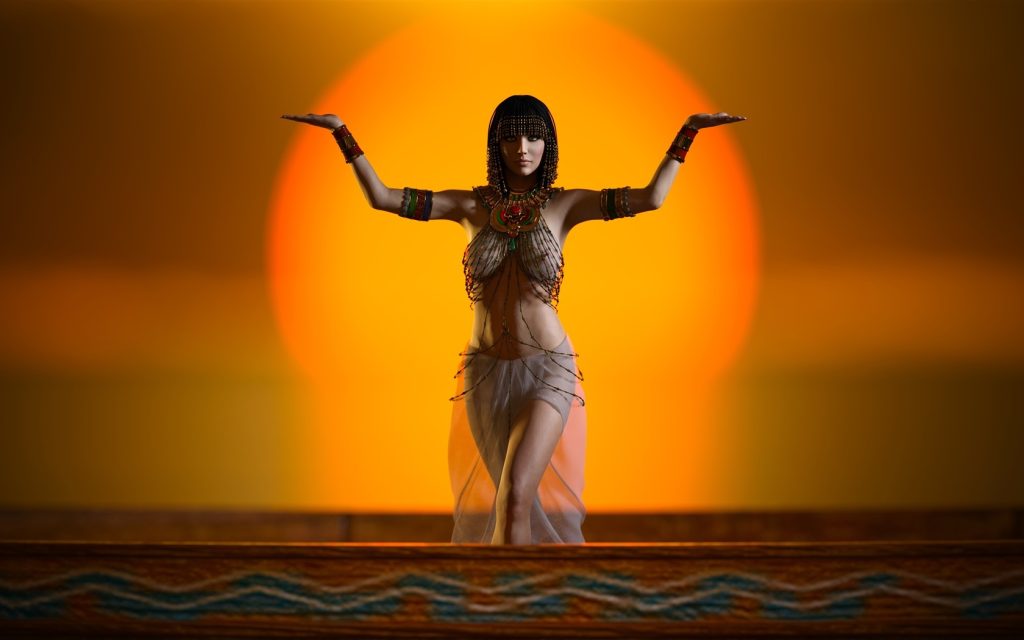Belly dance is an unusual art which has long history and deep rooting. This is an ancient ceremonial and ritualistic dance which attracts attention and is admired by many people around the world. Let us review its history and peculiars it has grown into in different countries.
Where the belly dance has emerged

Roots of the belly dance come from ancient times. It is considered that women of Ancient Egypt, the Middle east and Mesopotamia. From the prehistoric age women were dancing to express their happiness and common feelings. Having command of this art was being considered of special value in the ancient world. Slow and rhythmical movement of the hips was considered a mark of a woman’s health and her readiness to childbirth. This is how these ceremonial dances have become part of their culture and tradition.
What country is considered to be home of the belly dance

The belly dance has been found in cultures of different countries, however it is common to acknowledge its birthplace to be Egypt. This specific region in North Africa is considered to be the birthplace of the bellydance. The Egyptian bellydance is considered a mixture of ancient ceremonial dances, music, and singing. It is expressive, emotional, and is one of the important elements of Egyptian culture.
Specifics of the Egyptian belly dance

The Egyptian belly dance is characterized by graceful body movements, special rhythms, and emotional expression. It embodies femininity, beauty and elegance. the dancer uses her body to convey different emotions from happiness and love to to sadness and tragedy. This kind of dance has become popular and attracted attention not only within Egypt, but far beyond its borders.
Specifics of the Armenian belly dance

Armenian belly dance has its own history and cultural meaning. It is different from other dance styles thanks to it moderate energy and beautiful hand movements. Armenian dancers use soft and smooth movements accentuating the top part of the body. This style is distinguished by its unique and beautiful costumes with distinct national elements.
Specifics of the Arabic belly dance

Arabic belly dance also known is Raks Sharqi, has its roots in Arabic culture. This kind of dance is a mixture of graceful body movements, live music, and intriguing costumes. Arabic women costumes, like silk gowns and various decorations, are an integral part to this dance. Women, who perform in this genre express their lively energy and sensuality using a number of vivid and complicated movements.
Questions and Answers:
What was belly dancing originally used for?
Belly dancing, also known as raqs sharqi (or oriental dance), has centuries-long history. Initially it was used in the Middle East and North Africa as a cultural expression of femininity. IT was often used during wedding ceremonies, fertility rituals, and celebrations. It was also considered to have healing and therapeutic potential.
What culture is belly dance from?
The belly dance can be traced to different cultures, mainly from the Middle East and North African. It is closely related to such countries as Egypt, Turkey, Lebanon, Morocco and Iran. However it is worth making a point that the belly dance has extended beyond cultural borders and is now practiced and enjoyed in various parts of the world by various kinds of people.
Is belly dancing a hispanic thing?
No, belly dance does not have anything to do with Latino dances. Naturally, in some Latino countries there have their own unique traditional dances, however the belly dance has emerged from the Middle East and North Africa. It is important to value and respect cultural origins of the belly dance, without perceiving it as something particular only to certain specific cultures.
What religion is belly dancing from?
The belly dance is no associated with a particular religion. It has emerged under influence from different cultures and has been influenced by them overtime in many different ways. Even though it is widespread in countries with the majority of Islamic population, it is not related to any religious practice. Belly dancing has been accepted and used by people across different cultures and ethnicities as a form of artistic expression.
Belly dancing is a unique form of art with a rich history and many particular styles of performance across many countries. From different ceremonial dances to modern interpretation, belly dancing continues to enchant and inspire many people around the world.
What is belly dance?
Belly dance, also known as oriental dance or dance of the stomach, is a traditional form of dance originating from the Middle East. It is characterized by intricate movements of the hips and torso.
What is the history of belly dance?
The history of belly dance dates back to ancient times, with roots in various cultures like Egyptian, Turkish, and Arabic. It is believed to have originated as a social dance form and was performed in celebrations and ceremonies.
How many types of belly dance styles are there?
There are numerous belly dance styles, each with its own unique characteristics. Some popular styles include Egyptian belly dance, Turkish belly dance, and Arabic belly dance.
Can men be belly dancers too?
Absolutely! While belly dance is often associated with female performers, there are also male belly dancers who excel in this art form. It is an inclusive dance community.
How is belly dance different from other dance forms?
Belly dance stands out due to its exotic and mesmerizing movements, emphasizing isolations of different body parts. It has its own distinct style, often incorporating flowing movements and intricate belly dance movements.
Where can I hire a belly dancer for an event?
If you are looking to hire a belly dancer for your event, you can reach out to professional dancers or contact dance communities that specialize in belly dance performances. They can provide you with the information and options you need.
What are some common misconceptions about belly dance?
Many people believe that belly dance is solely for entertainment purposes or associate it with exotic performances. However, belly dance holds cultural significance and has deep roots in Middle Eastern traditions and dance traditions.
Is belly dance similar to other dance forms?
While belly dance may share some similarities with other dance forms, such as elements of hip movements, it has its own unique style and techniques that set it apart.









